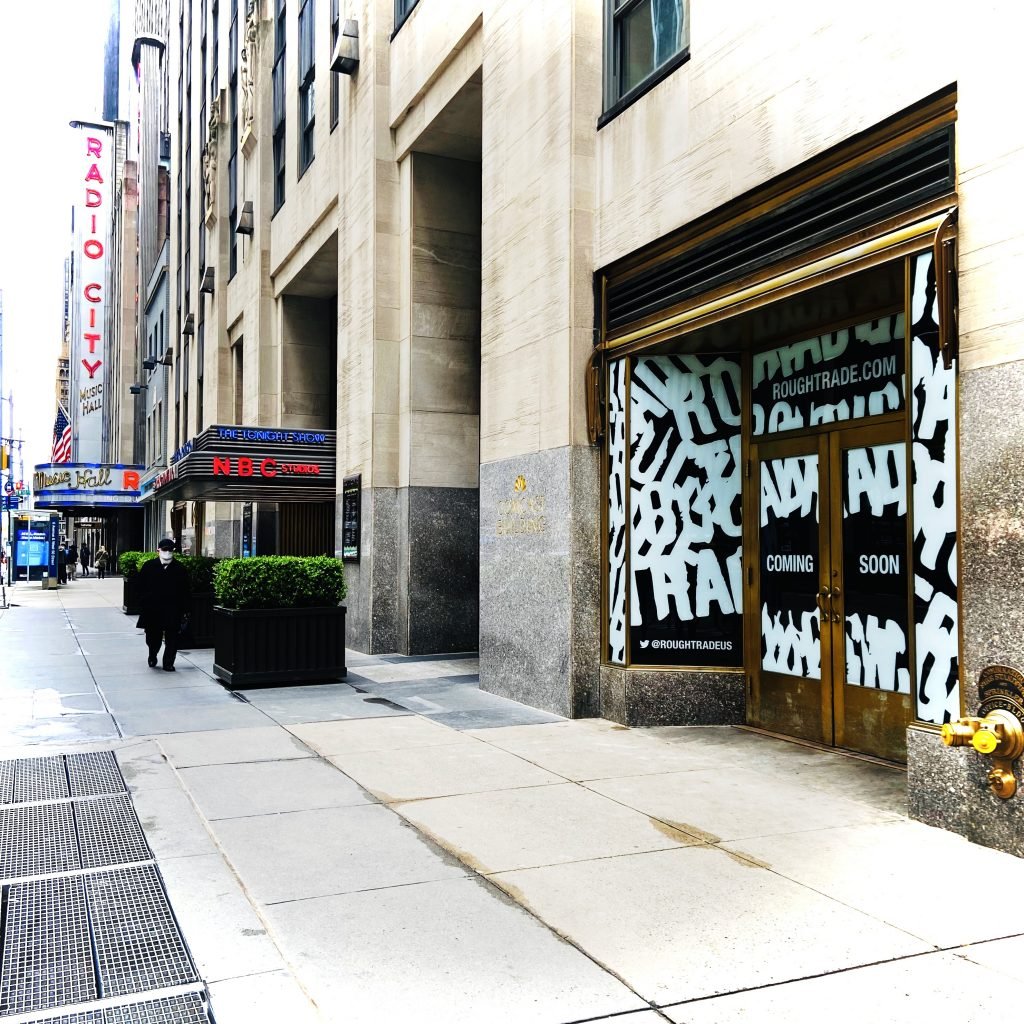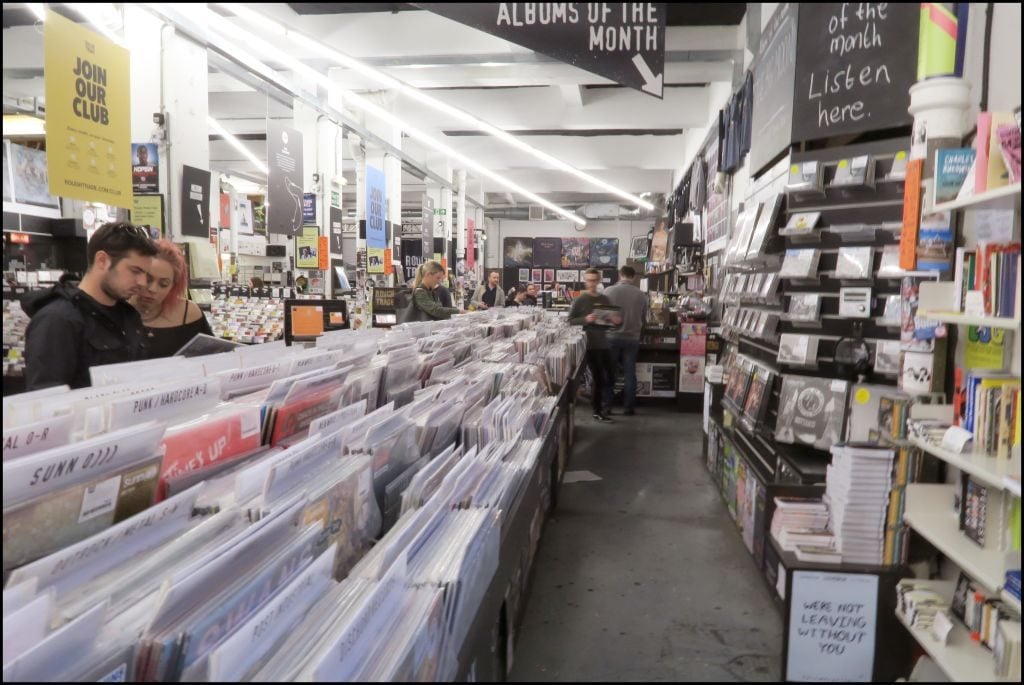Every Wednesday morning, Artnet News brings you The Gray Market. The column decodes important stories from the previous week—and offers unparalleled insight into the inner workings of the art industry in the process.
This week, on changing up without breaking down…
TRADE SECRETS
Next Tuesday, the British-born record mecca Rough Trade will reopen its New York emporium in a new location few vinyl heads would have ever anticipated: Rockefeller Center. Given the store’s celebrated history of championing the counterculture, the move to a Midtown tourism landmark could only have been made after working through tensions between art, identity, and commerce that will be familiar to any gallery in the “new normal” of 2021. That also means the way Rough Trade resolved those tensions should be useful in helping members of the art trade try to do the same.
For the uninitiated, the original Rough Trade record shop emerged in London in 1976. Founded in Notting Hill by Geoff Travis, it quickly became a nerve center for the international punk, hardcore, and DIY scenes—as vital an early foothold to British acts like the Fall and the Smiths as to American ones like Black Flag and Minor Threat. The shop’s success and influence convinced Travis to found a record label (called Rough Trade Records) in 1978, but the two entities permanently separated four years later when he sold the store to three of his employees.
Much like a gallery, the record shop always aimed to be more of a social nexus than just a store. Co-owner Nigel House put it this way to the Culture Crush blog: “Overall we have always wanted the shops to be places for people to come and hang out. I want people to come here, talk about music, buy music, see new music… We are trying to make it into a cultural hub.” Rough Trade hosted live performances, album signings, and other events; its programming options opened up further as the store branched out to sell books, magazines, and even skateboard gear.
The co-owners parlayed this participatory ethos into a broader expansion plan, too. By 2013, less than 40 years after the original shop welcomed its first customer, Rough Trade was operating four locations in London and the largest vinyl store in New York: a 10,000 square-foot compound in Williamsburg that housed more than 10,000 newly released and reissued records, an elevated stage for in-store performances, and a cafe. The AV Club called Rough Trade NYC “a special place where you could browse through records with your dog, find any kind of pop culture-related book you could imagine, and maybe catch a celebrity signing records or see a band you love doing soundcheck”—in short, exactly the kind of social and cultural hub its owners always strove for it to be.

The exterior of Rough Trade NYC’s new location at 30 Rockefeller Plaza, opening June 1, 2021. Courtesy of Rough Trade.
Like so much else in the arts, however, Rough Trade NYC’s supersized dream didn’t last. This January, the store announced it would close down its Williamsburg haven and move to “another, yet-to-be-announced NYC location” this summer. On May 10, the New York Times revealed that the new location would be none other than 30 Rockefeller Plaza (30 Rock), where Rough Trade’s neighbors will include the Tonight Show Starring Jimmy Fallon, the LEGO Store, and the New York headquarters of Christie’s. The store also announced that, instead of an intimate in-store setting, its live performances will be held at Rockefeller Center’s preexisting venues, such as the Rainbow Room, the plaza, and the ice-skating rink during warm-weather seasons.
Even the capsule history of the store I’ve given you above should suggest why Rough Trade’s change of address and context reverberate all the way to its foundations. To get a better sense of the calculus behind the decision, I reached out to co-owner Stephen Godfroy with some questions about three themes with bearing on both his shop and the art trade. Whether you agree or disagree with his answers, I think they are valuable as a tool to think through the issues in our own cultural niche.
1. Identity and Reputation
The Tension: So far, reactions to Rough Trade’s move have been mixed. Remember the AV Club’s love letter to Rough Trade’s Williamsburg spot? It was actually just the setup to a merciless strafing of the shop’s new location—one that labeled 30 Rock “every New Yorker’s worst nightmare” and the migration there “a terrible decision all-around.” As ever, social media users have been both much warmer and even colder, depending on which comments you read.
None of this should be surprising. Music is one of the few jurisdictions that polices “authenticity” and street cred as viciously as the art world. Whether you’re a young woman artist playfully trolling the Very Serious Men in the old guard, or a long-respected seller swapping out locales for access to a different audience, a legion of cultural referees are always salivating for the opportunity to pass judgment. In a sales space where perception regularly handcuffs facts, that makes weighing the costs and benefits of relocating to a more visible spot even more difficult to parse.
The Thinking: What some critics have portrayed as selling out, Godfroy instead portrayed as a trend-bucking return to form. “Traditionally, Rough Trade and Rockefeller Center are not obvious bedfellows,” he said, “but therein lies the dazzling, daring opportunity for us to defy worn-out convention, to respond to the rethinking of cities caused by the pandemic, to reach wider and more diverse audiences, to unite tensions of the past into new unified bonds of the future.”
In this line of thinking, nothing could be more in step with the store’s rebel mentality than “shaking off the Williamsburg/Brooklyn record-store stereotype” and parachuting into Midtown, an area overrun by precisely the opposite of the store’s expected constituency.
In fact, Godfroy told Jenn Pelly in the Times that he’d been contemplating relocating to Manhattan as far back as summer 2019. The idea was to be more central to a growing audience of casual vinyl fans, particularly since foot traffic in Williamsburg tended to stay light during the workweek even before last year’s global catastrophe. He framed this to me as Rough Trade’s responsibility in its role as a “trusted interface” between artists and music lovers.
“We owe it to the artist community to maintain our edit and curation (championing exciting, new, emerging music) but to reach as wide an audience as possible. To achieve that in New York—where change is the dominant melody—we’re unafraid at taking a bold step whilst staying true to ourselves: a record store for the people, but now connecting with more people than ever before.”
The Question for Galleries: In a post-shutdown economy, can you reach your goals by doubling down on the same audience you were catering to before the world stopped? If not, are you mentally prepared to shake off the heckling you’ll inevitably receive for making an unorthodox but potentially transformative move of any kind?

Yacht performs at Rough Trade’s Williamsburg, Brooklyn store on November 5, 2015. (Photo by Nicky Digital/Corbis via Getty Images)
2. Optimizing Real Estate
The Tension: While Rough Trade’s new home will still contain around 10,000 records for crate-diggers to explore, it will take up only about 2,100 square feet—less than 25 percent of its footprint in Williamsburg. This is partly because of the absence of an in-store performance stage, and partly because online customers will now be served by an e-commerce fulfillment center back in Brooklyn (Greenpoint, to be exact).
On paper, then, the reduction in physical space comes at no cost to Rough Trade’s primary function as a major New York vinyl shop. At the same time, by forcing its online consumers and concertgoers to go to related-but-separate destinations instead of the main store, the loss of square footage would seem to threaten the “cultural hub” approach that defined Rough Trade from the start.
The Thinking: Godfroy acknowledged that the move to 30 Rock will lead to some churn in the store’s clientele, as any relocation would. But he believes decentralizing will have less of an effect on its social fabric than conventional wisdom would say. “The fact that people can now engage with music in multiple ways liberates us to locate wherever we’re best able to unify once-disparate audiences,” he said.
In other words, it isn’t a problem in the digital age to send different slices of Rough Trade’s New York audience to different Rough Trade-affiliated destinations in the city if they want different things. The real risk would be to hold onto an all-purpose mega-location that would prevent Rough Trade from reaching untold numbers of music lovers using the internet and other 21st-century developments to satisfy their cravings somewhere else.
Counterintuitively, sellers operating more than one location might actually be less inclined to think through this question than their single-location peers. The standard impulse when expanding is to replicate as much as possible about what worked the first time, every time. Godfroy warned against such a rigid approach, emphasizing that each Rough Trade store is its own entity. The brand stays cohesive because of the underlying elements (“great records and great people”), regardless of whether each location has its own stage and cafe.
“Wherever we are, we’re a place of community, with visitors from across the street, across the city, across the hemisphere—for music appreciation is without borders, and so are our stores by return.”
The Question for Galleries: Is the only way to forge a strong bond with your desired audience to program everything you do in the same place, particularly if there’s a more efficient option? Or can you be more effective by thinking more flexibly about real estate, geography, and technology?

Kendrick Lamar signs copies of “To Pimp A Butterfly” at Rough Trade NYC in March 2015. (Photo by Mike Pont/Getty Images)
3. Championing Physical Objects in a Digital Culture
The Tension: When I say Rough Trade is a record store, I mean it in the most literal sense. Vinyl is its core product—again, strictly new releases and reissues, not used and rare records. Even when its shops have branched out, the additional offerings have still almost exclusively been objects you can hold in your hands, like books, posters, and apparel.
If you find a standalone digital recording for sale in its U.K./E.U. online store, it means you’ve wandered through some slit in the curtain of reality into an alternate dimension. (Select records do come packaged with an accompanying MP3 version.) The U.S. e-commerce site did offer download-only albums for sale as of publication time—exactly 26 of them.
So even as Rough Trade’s sales strategy has evolved to embrace customers who prefer to shop digitally, here in May 2021 the store remains defiantly committed to analog inventory. That won’t change when the New York store reopens at 30 Rock.
The Thinking: According to Godfroy, it’s simple: Rough Trade still believes physical pieces of culture provide “multisensory stimulation, presence, and value that has no equal substitute.” It goes without saying that this mentality aligns the store with the vast majority of art dealers who have not yet broadened their horizons to sell new media works.
Setting aside Christie’s recent headfirst slide into the NFT field, staying committed to analog cultural objects in Rockefeller Plaza also puts Rough Trade in close company with the global auction house. Although Godfroy admitted that he and the other co-owners weren’t aware they would be sharing Rockefeller Plaza with Christie’s New York headquarters until I mentioned it, he noted that the two brands “certainly share a common appreciation of the artifact in a digitally driven world.”
But the migration to Midtown had nothing to do with trying to upgrade Rough Trade’s esteem in the cultural business. To return to our first theme, Godfroy said the “key driver” of the choice was “that this area of the city was crying out for some counter-culture, crying out for disruptive, provocative change, which is something we aim to provide in spades.” Holding fast to vinyl in the age of streaming is just another plank in that same campaign.
The Question for Galleries: Do you have to pivot to dealing a significant amount of software to succeed going forward? Or can you refine your digital strategy while continuing to champion actual objects you believe in?

Lauren Mayberry of CHVRCHES performing at a SiriusXM private concert at Rough Trade NYC on September 25, 2015. (Photo by Robin Marchant/Getty Images)
Ultimately, none of the dilemmas around relocating in New York could have been easy for Godfroy and his colleagues to resolve. No matter what they chose to do, each answer would fundamentally impact the way artists, longtime customers, and new audiences would engage with the brand.
From real estate to e-commerce, and from past history to present market conditions, independent art dealers around the globe have to make their own hard choices about how to adapt in an industry rocked by change. Looking at Rough Trade’s approach in an adjacent cultural economy may not provide the answers galleries need. But in a post-shutdown market, trying to simply spin back the same old record again could be the surest way for dealers to ensure the music stops for good.
[The New York Times]
That’s all for this week. ‘Til next time, remember: if no one hates what you’re doing, you’re probably not doing anything that matters.










